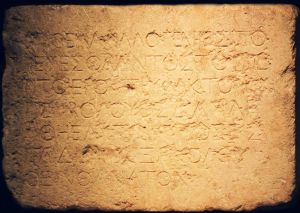So.reg Inscription (also known as Temple Warning inscription) was found in the temple courtyard during the second temple excavation in the city of Jerusalem in 1871 by two famous archeologists named Clermont and Ganneau. Whether the priests of the temple in Jerusalem had the right to execute the trespasser or it was just a simple curse is still unknown since the second temple was in the political borders of the Roman Empire and the Romans had the ultimate authority in Jerusalem. Let’s have a brief look at the Temple Mount history before we speak about Soreg Inscription (also known as Temple Warning inscription) which is exhibited in Istanbul Archeology Museum today.

Soreg Inscription in Istanbul Archeology Museum Visualization of Soreg Inscription
The First Temple
The First Temple in Jerusalem is the son of David, Hz. It was built during the reign of Solomon and completed in 957 BC. The first Temple was built as the shelter of the Ark of the Covenant and a meeting place for the people. Therefore, the building itself was small, but its courtyard was very large. The Babylonian king Nebuchadnezzar II seized the temple treasures in 597 BC and in 586 BC completely destroyed the building.
The Second Temple
The Second Temple lacked the sacred items of the First Temple; especially the Ark of the Covenant. The uprising against Rome in 66 AD started in the second temple and ended in 70 AD when the Romans destroyed the temple. Today, the famous wall in Jerusalem city is one of the current remains of the second temple. Two important inscriptions belonging to the second temple are exhibited in the Istanbul Archeology Museum today. We should consider ourselves lucky to have these inscriptions from the Temple Mount since the level of destruction on the Temple Mount was so extreme.
Background of Soreg Inscription
In temple times, access to the inside sections of the holy temple was limited by a complex set of purity laws. Non-Jews were prohibited from entering the inner courtyard of the Temple. The stone inscription outlined the prohibition of non-Jews beyond the wound separating the greater Court of Gentiles from the domestic courts. Warning signs were made both in Greek and Latin languages which were the most common tongues in the Roman Empire. Terms of temple architecture such as Tryphaktou, Peribolou, and To hieron appear above the inscription.
Soreg Inscription in Holy Bible
This inscription is also mentioned by Apostle Paul in the Holy Bible on the verse Ephesians 2:14.
For he himself is our peace, who has made the two groups one and has destroyed the barrier, the dividing wall of hostility, by setting aside in his flesh the law with its commands and regulations. His purpose was to create in himself one new humanity out of the two, thus making peace, and in one body to reconcile both of them to God through the cross, by which he put to death their hostility.
Ephesians 2:13
Translation of Soreg Inscription
ΜΗΘΕΝΑΑΛΛΟΓΕΝΗΕΙΣΠΟ ΡΕΥΕΣΘΑΙΕΝΤΟΣΤΟΥΠΕ ΡΙΤΟΙΕΡΟΝΤΡΥΦΑΚΤΟΥΚΑΙ ΠΕΡΙΒΟΛΟΥΟΣΔΑΝΛΗ ΦΘΗΕΑΥΤΩΙΑΙΤΙΟΣΕΣ ΤΑΙΔΙΑΤΟΕΞΑΚΟΛΟΥ ΘΕΙΝΘΑΝΑΤΟΝ
No stranger is to enter within the balustrade around the temple and enclosure. Whoever is caught will be himself responsible for his ensuing death.